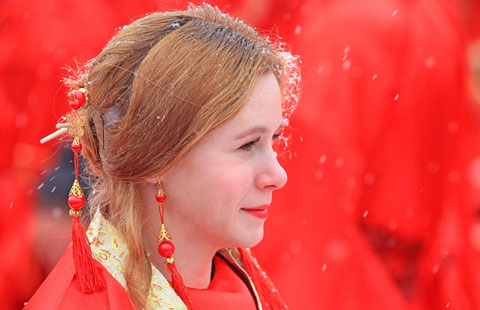A step forward to marketize yuan’s exchange rate
Updated: 2014-03-19 09:27
By Li Yang(chinadaily.com.cn)
|
||||||||
The People’s Bank of China’s third adjustment of the yuan’s daily trading range is in line with the direction of China’s market reform, according to an article by China Business News. Some excerpts:
PBOC said on March 15 that renminbi’s exchange rate against the US dollar will be allowed to rise or fall 2 percent from a daily midpoint rate it sets each morning. The change was in place from March 17.
This is the third time for China’s central bank to enlarge yuan’s daily trading range since 2005, another stride for China to marketize its currency’s exchange rate.
PBOC enlarged the range from 0.3 percent to 0.5 percent in May 2005, and to 1 percent in April 2012.
Exchange rate is an important factor influencing the allocation of foreign and domestic resources. Enlarging the floating range of yuan’s exchange rate can effectively boost the flexibility of renminbi’s exchange rate, optimize the distribution efficiency of capitals, and play up the market’s roles.
But the limited scope of the change shows the central bank is considerably prudent. Analysts predicted the change would be 2.5 percent to 3 percent. The final decision on 2 percent indicates the central bank intended to carry out the reform step by step.
As the central bank explained: “The adjustment gives a full consideration to the adaptive capacity of the Chinese economy, and the change falls in the tolerable scope of various main market players.”
This is also a style that the market is familiar with. The formation mechanism of renminbi should be reformed step by step in a controllable way.
The condition of a nation’s current account is an important criterion for judging whether its currency’s exchange rates are reasonable. Zhou Xiaochuan, governor of PBOC, revealed recently that reforms of the exchange rate, foreign exchange administration and other areas should be carried out now. It seems China’s central bank has already seen now as an opportunity to promote exchange rate reform.
Renminbi has continuously appreciated against the US dollar for years. After China deepens its market reform of yuan’s exchange rate, renminbi will fluctuate with increasing volatility against the greenbacks.
PBOC will reduce its intervention with the exchange rate. China is moving closer to its target of building a managed floating exchange rate mechanism based on market supply and demand.
China should do more than the adjustment. The government should create better conditions and environment for the development of risk management, risk hedging and investment products, improve the market-maker system, further develop the foreign exchange market and financial products of foreign exchange, and help import and export enterprises and cross-border investment agencies to hedge the exchange rate risk and interest rate risk.

 Music at her fingers
Music at her fingers
 Across America Over the Week (Jan 16 - Jan 22)
Across America Over the Week (Jan 16 - Jan 22)
 Spend Chinese New Year in style
Spend Chinese New Year in style
 Ili river valley becomes a popular destination for swans
Ili river valley becomes a popular destination for swans
 Philip Ma: from scientist to businessman
Philip Ma: from scientist to businessman
 Birmingham's Spotlight on China dinner
Birmingham's Spotlight on China dinner
 How to distinguish doucai, wucai, Famille-rose and enamel porcelain
How to distinguish doucai, wucai, Famille-rose and enamel porcelain
 Xinjiang lake in bumper fishing season
Xinjiang lake in bumper fishing season
Most Viewed
Editor's Picks

|

|

|

|

|

|
Today's Top News
Houston's SW Chinatown
China to focus on reforms, opening of capital market
Slowdown brings new risks to banks
Trade group calls for BIT
Market status for China is 'political' issue
Birmingham's Spotlight on China dinner
Bank takes renminbi-clearing seriously
Traditional Garb
US Weekly

|

|







